Subscribe now to get notified about IU Jharkhand journal updates!
Gamification: The Conclusive Engagement Lever
Abstract :
Employee Engagement is determined as the most important challenge in the contemporary HR field. Managers are always burdened with enlarging the engagaement dimensions of employees. Gamification has always standout amongst the most exceptional technique for engaging employees. The methodology of gamification receives the human conduct of including in gaming exercises and verbalizes it with their work with the expectation to upgrade engagement. The present paper is based on extensive literature on gamification and employee engagement. It goes for dissecting the pertinent gamification structure models. Gamification impacts employee conduct through motivation as they are stirred by rewards and acknowledgment. Starting at now numerous organizations have distinguished strides to gamify the work environment, yielding processable outcomes in connection of worker commitment which relate with execution, maintenance and profit related outcomes. Gamification applications equip the diversion mechanics and inspirational strategies to acquaint minimal sound rivalry with the work environment and harbor employee behavior required to achieve enhanced business results. The paper finishes up by evaluating the genuine use of gamification by the associations in boosting employee engagement.
Keywords :
Employee Engagement, Gamification, Human Resources, Employee Behaviour1. Introduction
Employee engagement is the emotional commitment the employee hold to the organization and its objectives. It is defined as the extent of an employee s psychological investment in their organization. Leaders are frequently encumbered with augmenting the engagement levels of employees. They generally offer rewards for performing better, generate consecutive levels of ever growing challenge and award, or facilitate top performers public appreciation in the forefront of their colleagues. But Gamification of work is a modern approach which is more promising. Workplace Gamification is nearly an advanced approach. Issues such as collaboration, learning as well as engagement could be mitigated through gamification used by enterprises. Application of game elements to non game contexts is termed as gamification which is not mere game playing. Only scanty academic studies are there which have examined the disparate frameworks of Gamification. Although it’s early for HR in the gamification, game design and game mechanics represent reassuring tools for the field, notably for learning exercises such as training, safety education, onboarding, team building as well as career development. This kind of learning is advantageous to employees as it is available whenever they need it, since most options are developed for computers and smartphones. Training often leads to work that is more intrinsically rewarding (Prasad And Singh 2016). As of now many companies have identified steps to gamify the workplace, yielding computable results in relation of employee engagement which correlate with performance, retention and financial results. It impacts employee behavior through motivation as they are motivated by rewards and recognition; it also facilitates a sense of control through the gamification apps which taps into their intrinsic motivation. It does provide clues to action as where they are leading together with a sense of competition. Gamification is a design discipline which must be practiced consistently to generate expected results. We can leverage social networking as a plan for employees to notice each other or linking to each other’s work portfolios. Gamification, a growing digital platform applied by many large organizations, has made technology to shift from everyday routine business processes to more non-traditional roles such as motivation, training and collaboration. Over these game-allied elements, Werbach (2012) recommended that one can upgrade employees’ normal tasks through a component of fun, resulting in an enriching work experience as well as improving employee’s engagement. Although gamification is not compelled to technology, organizations with the usage of social media are distributing game allied elements with the help of technology. The concept of Gamification and various game theories are coupled to various practices entrenched in fields like sociology and psychology, which are applied in the game-allying elements conveyed by technology. The intent is employee motivation and engagement for performing well to achieve organizational objectives. Academic literature shows scanty gamification studies and henceforth available business literature is used to support the academic work. In this regard the aim is to amalgamate the varied elements of Gamification and demonstrate that the approach is practical and useful for an organization for positive business outcomes. In this article, the concept of Gamification, various gaming theories and models have been identified and actual application cases of Gamification are reviewed. Various existing models of Gamification that are qualitative in nature are reviewed. Some of the model originate as Academic model as given by Fogg (2009) and some are designed by industry as the DiTommosa (2011).
LiteratureInsight
Kahn (1990) defined personal engagement as “the simultaneous employment and expression of a person’s ‘preferred self’ in task behaviors that promote connections to work and to others,
personal presence, and active full role performances”. Maslach et al. (2001) postulated that employee engagement was the positive antipode to burnout and described it as “a persistent positive affective state characterized by high levels of activation and pleasure”. “Employee engagement refers to the individual’s involvement and satisfaction with as well as enthusiasm for work” (Harter et al., 2002,). Gallup Organization (2005) described employee engagement as "the involvement with and enthusiasm for work". Using 102 working employees enlisted in a graduate course at a large Canadian university, Saks 2006 ascertained that employee engagement is a specific and exclusive constitute comprising of cognitive, emotional, and behavioral elements. Those employees are engaged who invest them mentally and emotionally towards their work and contribute to their organization’s success. (Czarnowsky 2008). Macey and Schneider (2008) established conceptual research in the field of employee engagement. They discovered that employee engagement originates from trait, state and behavioral engagements. Some of the early relevant work in the area of employee development is shown in figure 1

Figure 1. Source (Shuck, B., & Wollard, K.,2010)
Chartered Institute of Personnel Development (CIPD) analyzed and has established linkage between the ways people are persuaded, employee attitude and organizational performance. It is concluded that employee engagement is an ambidextrous design. Crim and Seijts (2006) defined employee engagement as when an employee is completely diversified in and enthusiastic regarding his work. Gamification provides measure to engage employees. Werbach (2012) concluded that Gamification in itself is not a real game, but an array of game-allied elements that are incorporated into non-game operations .according to Kevin Werbach (2014) gamification is “using design techniques from games in a business context or some other non-game context”. Woods (2012), from a business point of view stated that “Gamification is about achieving goals using an engaging set of metrics-based interaction.” Gamification acquiesced managers to connect these metrics for their members, helping them to reduce feedback cycles, which henceforth upgrade feedback to the user. Conventional methods consistently provide employees feedback on a perennial cycle laid out by HR policies and practices. The feedback cycles are qualitative in nature and does not always depicts the real performance of an employee. Gamification is an integral part of this cycle and permit mangers to measure performance in a quantifiable manner. Conclusively, Gamification needs to be incorporated within the systems. “Gamification can actually become an integral part of the process design for business”, Woods (2012). According to Aberdeen Group (2013) companies that apply gamification have improved outcomes such as engagement, productivity and retention. Gartner Group (2011) forecasted that
gamification will be a leading trend that each IT administrator, CIO and enterprise engineer should be acquainted with as it divulges to business. Modern generation of workers are more focused on the varied usage of their knowledge, expertise and ingenuity and are awaiting for freedom and autonomy at work which lead gamification to be as relevant as ever (Kamasheva, Valeev, Yagudin & Maksimova, 2015 Deterding et al. (2011) defined gamification as "the use of game design elements in non-game contexts". Werbach and Hunter (2012) concluded that elements of a game-design comprise of dynamics, mechanics and components which are intertwined all together. Werbach (2011) categorized different kinds of Gamification. External Gamification is the most substantial type and i is applied in marketing and sales. It can also be used for customer service points. It can be applied to credit cards that offer points and persuade customer to spend. Internal Gamification, which is applied in HR functions eg. Hiring and training along with productivity intensification in activities related to collaboration. The Gartner Group (2011) predicted that by 2015, 50% of all companies will gamify systems and processes. Bunchball (2010) stated, “Gamification applies the mechanics of gaming to non-game activities to change people’s behavior.” The goal of Gamification is to increase participation and engagement as well as positive business outcomes. McGonigal (2011) sustained The Gartner Group affirmation and stated that on neglecting games would be at disadvantageous position on account of not knowing how to leverage games into their systems .this will lead them to lose future opportunities. Meloni and Gruener (2012) stated that gamification market has been expanding exponentially as shown in the graph. Figure 2. backed Gartner’s prediction of Gamification budding by the next few years.

Ditommaso (2011) delivered One of the first gamification frameworks. According to him there are seven facet of Gamification to be studied. the seven areas he referred to are the needs of the business which is to be gamified, considering your users,thebusiness objectives, skills to be identified, the game elements ,the positive outcomes and last application i.e play and polish. Each component could be verified by the company that has successfully actualized Gamification.The reason behind enumerating Gamification to a workplace is to enhance previously existing systems. Mehta and Kass (2012) stated that “incenting behaviors which employees already know they can and should perform, but which they might otherwise
procrastinate about, or ignore altogether.” This proposed that companies should know the status of their business before implementing Gamification within their systems. Gartner Group (2011) described that main purpose of Gamification “are to achieve higher levels of engagement, change behaviors and stimulate innovations”. Burke (2011) businesses cannot neglect Gamification as it targets on enhancing engagement with their stakeholders. Although business perceived that Gamification is technology-empowered, Mehta and Kass (2012) illustrated that it falls under persuasive technology which Fogg (2009) model used to alter the attitude and behavior of employees. It requires the understanding of the need for the change in behavioral respect. Mehta and Kass(2012) ascertained the relevance of mapping the required alteration of behavior and the kind of game administered. Enterprises must beforehand scrutinize their strategic goals and coordinate employees towards the set goals if Gamification is applied as persuasive technology. The desired behaviors that lead employees towards their goals shall b addressed by gamification. Fogg’s (2009) eight step persuasive technology is shown in figure 4:

Frang and Mellistrand (2011)concluded games can make almost any activity more engaging and conducive to learning by applying game dynamics to everyday experiences.
Another model given by Dignan (2011), when characterizing a behavior game, the outermost ring is the “Activity” which conveys what we need to attain through gamification. The employees are “Player Profile” who is attracted towards game. The last are” Objectives” and “Outcomes”, where attaining or not attaining the objectives come out as an outcome. The next layer of Dignan’s model is The Skill Cycle. This depicts the span of time these behaviors are executed. Rules engines that is black box represents the action performed by the users and also provides feedback to the user in a meaningful manner who examines the consequences and then take the best action suited as per the game rules.( Frang and Mellistrand 2011 ). It is worth noting that Dignan’s gaming model differentiate actions from feedback, in the process of gamification the main aim is to acquire what the user is attaining within this system. Building blocks are the innermost layer which exemplifies the skills and expertise of the players, the resources needed and the hurdles or difficulties in the game. Earlier Gamification commence with simple tasks, as users go over skill cycles and attain skills and henceforth the gamified systems pitch more hurdles as a player proceeds. There is a match between the correct skills and right challenge and this is the most engaging element of the game. McGonigal (2011)showed that there are four shared traits ( goals- outcomes, rules-blackbox, feedback and participation – outside layer) to describe all games and the mentioned traits are included in Dignan’s model shown in figure 5.
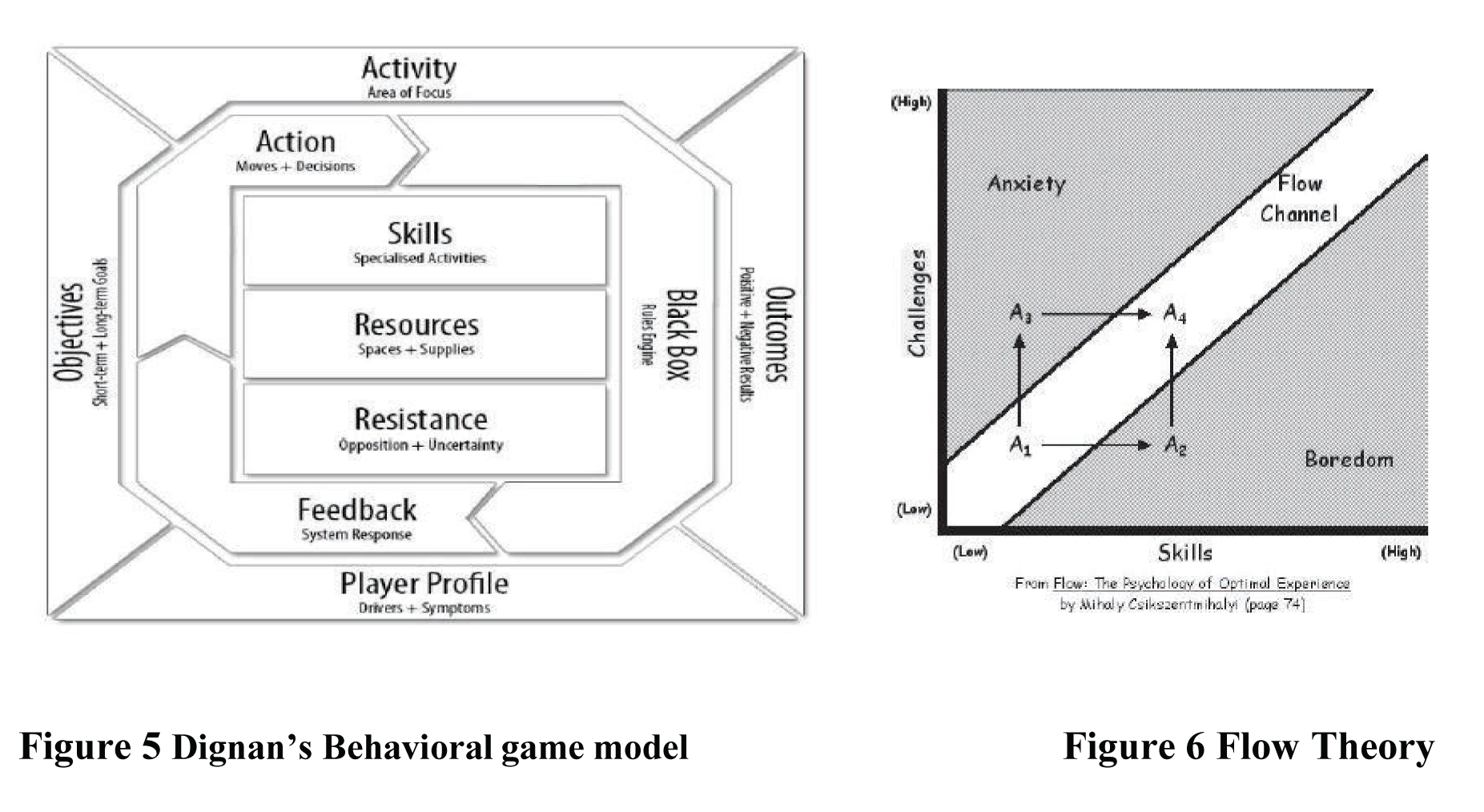
The fundamental goal in Gamification is to alter behavior. Xu (2011) concluded that for modifying behavior the components required are motivation ability and trigger which needs to combine simultaneously for a specific behavior to occur. Games are applied to elicit favourable flow and to mitigate the boredom which could arouse from certain jobs. Games could have numerous asthetics which depends on the objective of the business. There is no standard combination of games to attain organizational‘s objectives. Evaluation of Goals depends on individual basis to know which is suitable to work best to attain the goals. The agitation of the game should conform to the game aesthetics to make the conducive environment in which the player can adapt the required behaviors of the organization. Hunicke , LeBlanc and Zubek R. (2004) suggested three distinct components of game called“MDA”.
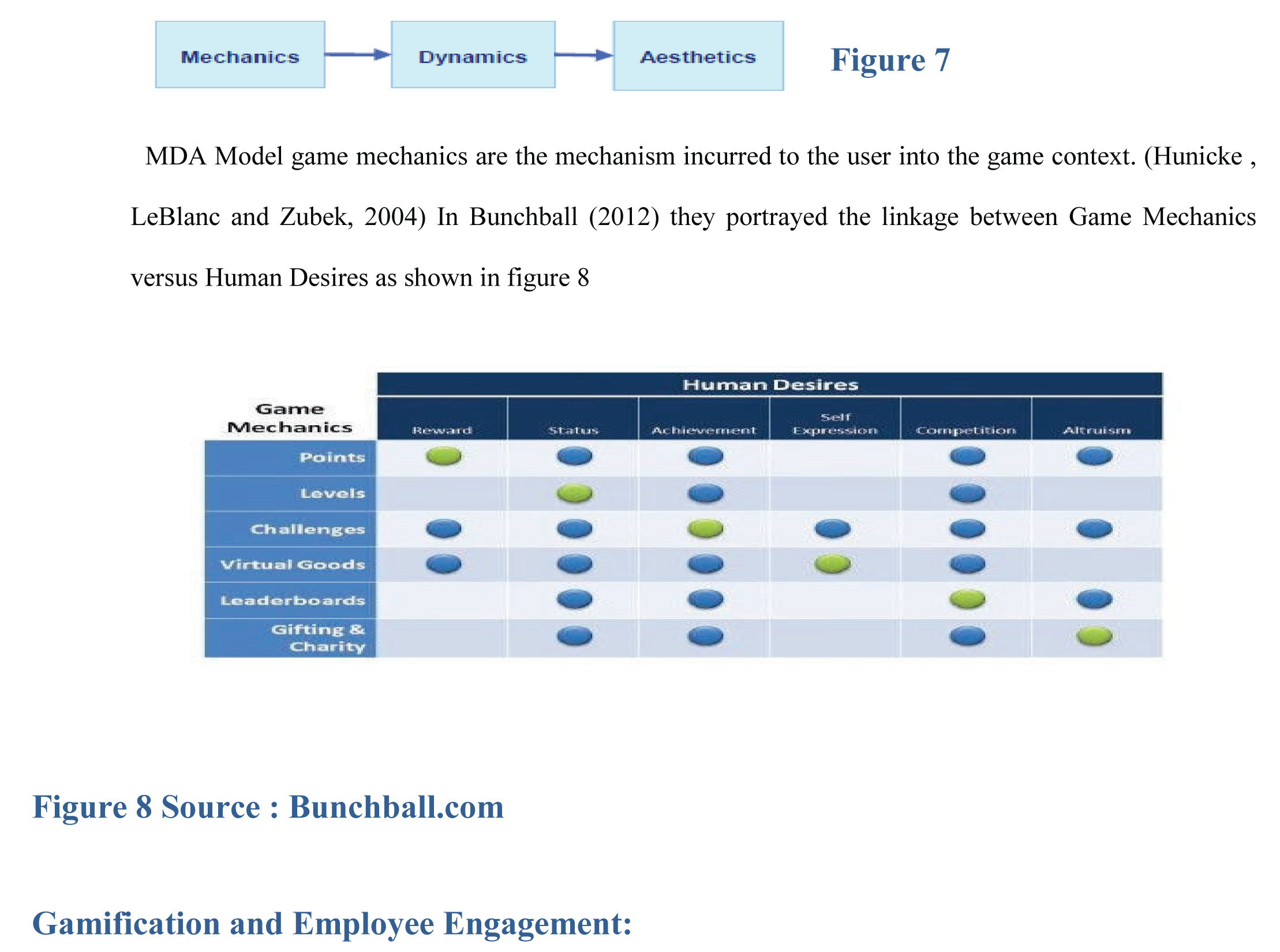
Meloni and Gruener (2012), showed that engagement (figure 9) is the key issue organizations need to fix. Due to lower engagement, employee’s happiness and performance gets affected.
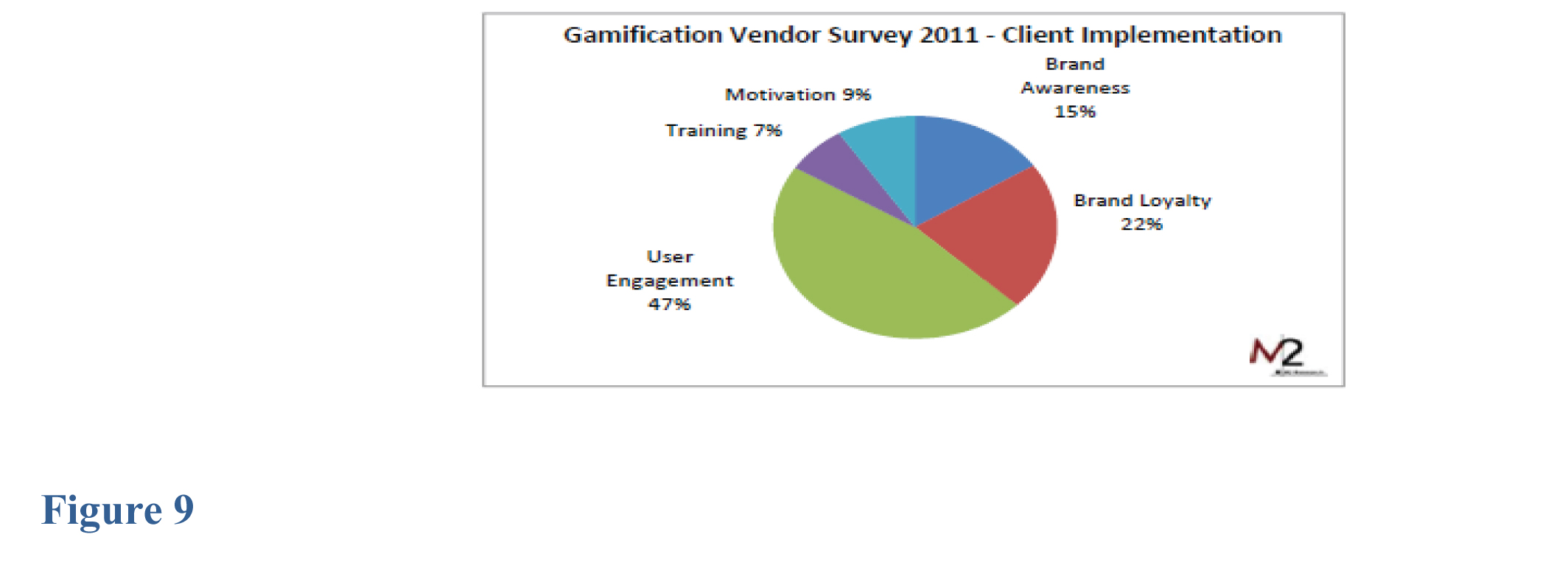
Some of these challenging issues could be solved by workplace gamification. The approach of digital motivation with the support of gaming assures new engagement within employees all around the world. It doesn’t imply turning work into game but rather affecting the psychology that pushes employees to improve, perform and rewarded. Organizations crosswise industries are switching to gamification to boost employee engagement. To engage customers Gamification is employed by many organizations with the usage mobile apps social media to carry out contests and rewards. Notwithstanding, organizations incorporate game elements within their system to boost up performance by engaging employees. Gamification is the digital platform which has emerged as technological component that forms a linkage between employees and organizational objectives. Global researchers predicted that this emerging concept worth will be $5.5 billion by 2018, in comparison of its present size of $421 million. Game design methods like getting rewards on crossing a level and earning badges are being implemented by the corporate to enhance employee engagement, motivation and training. Cisco invested in the training program which was build to enhance the social media skill sets of the employees Gamification at SAP used gamification to boost user participation and engagement through recognition program points. Points are achieved on contribution to the surrounding through blogs, forums and whitepapers. NTT Among 500 top innovative enterprises NTT Data ranked 206 in the world ( Information Weekly Magazine)for applying social Gamification in its collaboration podium for employees (Jantzen 2012). According to Meraj (2012), NTT Data is employing Gamification to attain two business goals . first to engage employees in elearning and other is use it in marketing campaign. The TimesJobs research affirms that tech organizations adopted gamification primarily to apply it in hiring an denaggaing employees. Non It organizations also uses this digital platform in recruiting the professionals. Many Indian companies used gamification as a medium to hire, train,engage and improve performance of the employees .Around 85% of BFSI and Manufacturing sector applied gamification in coding contests for engagement and branding purpose. Many organizations in India use gamification as a platform to engage, train, hire and improve the productivity of their employees.HCL incorporate games for hiring purpose and employ games in different phases of the employee life cycle.this tool is beneficial more for hiring the middle management as compared to senior and junior level.
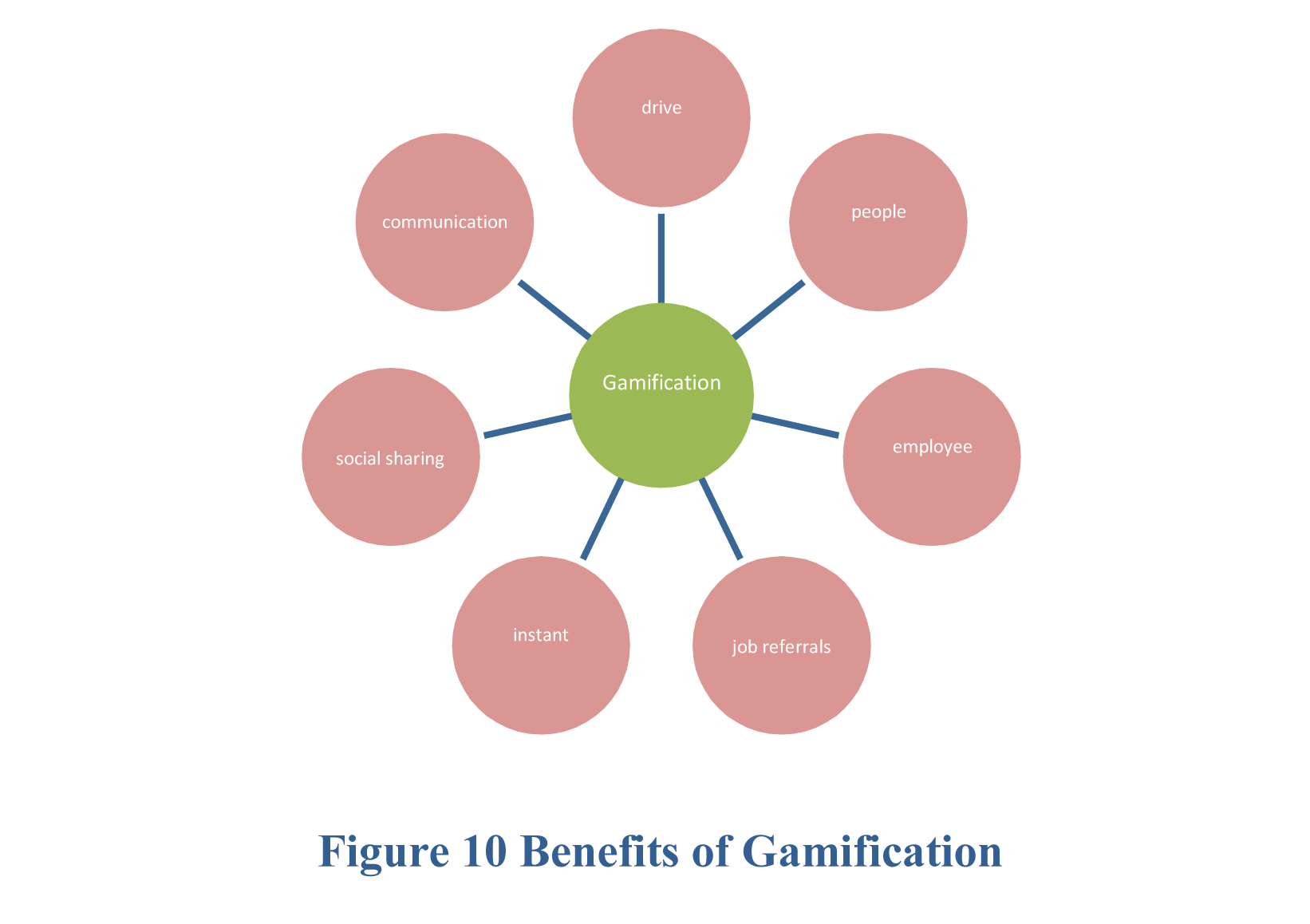
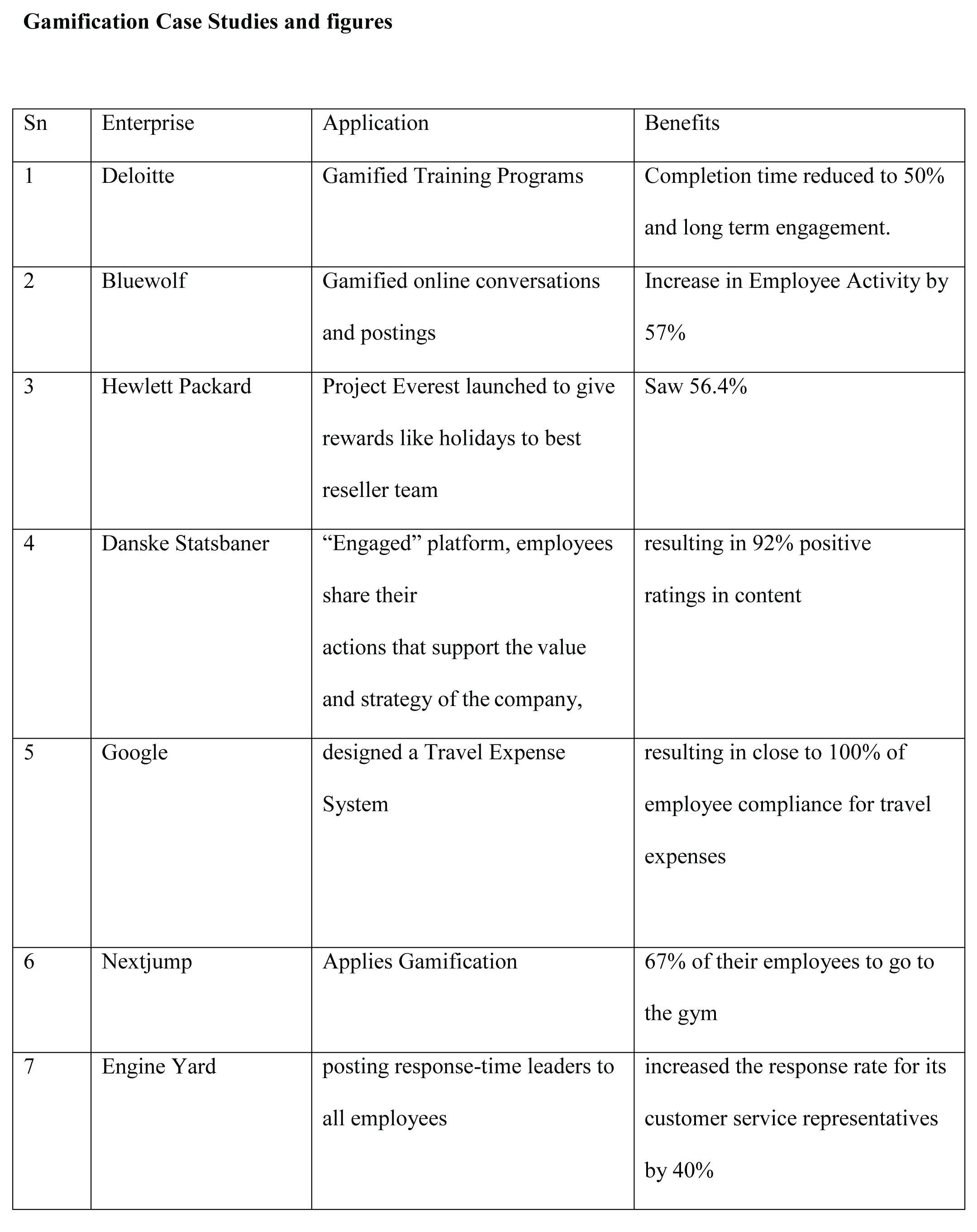
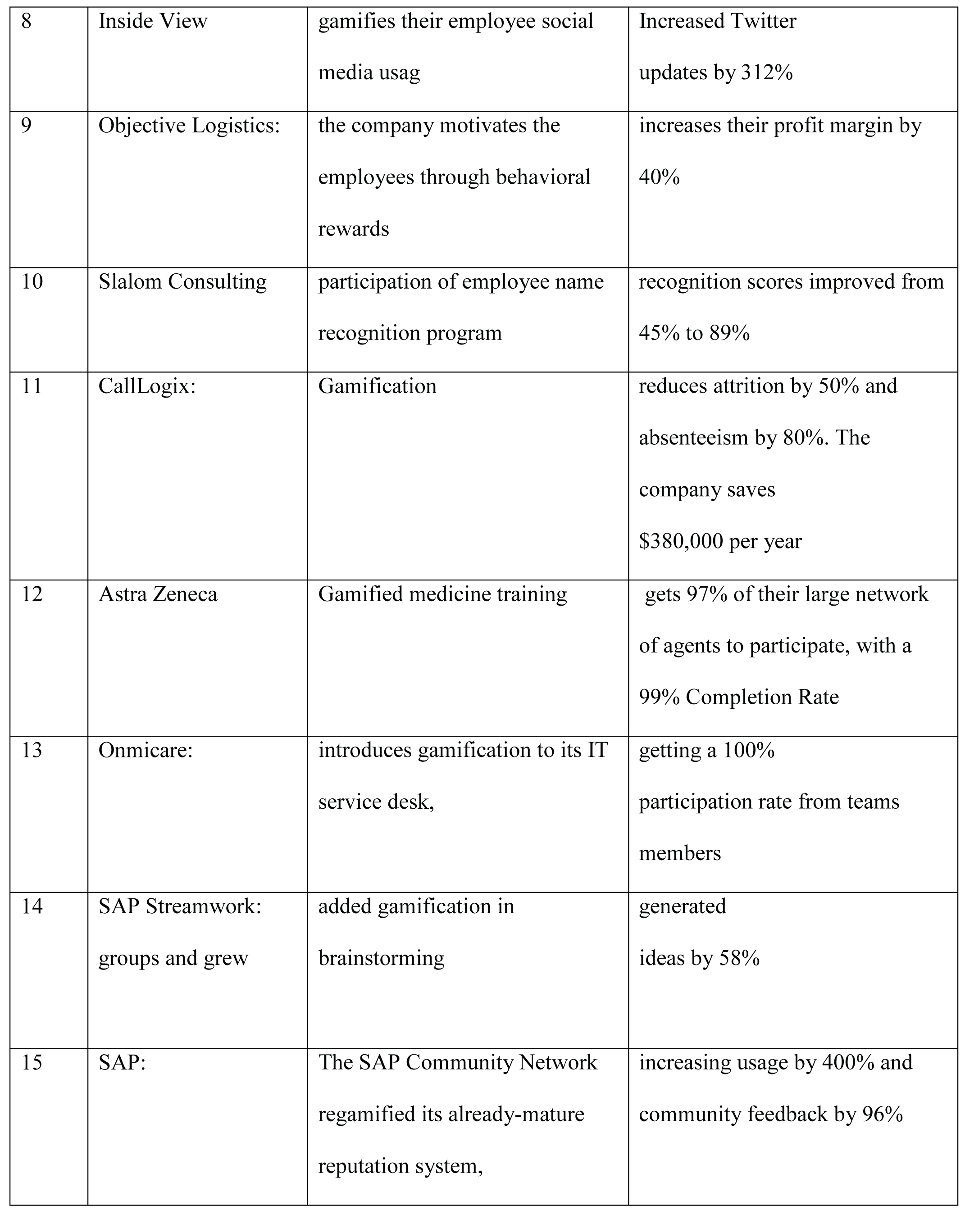
Table 1 Source Chou, Y. K. (2016) Chou, Y. K. (2016) Gamification & Behavioral Design . Research Methodology
The literature review method was suitable since it is an approved strategy for outlining literature about a concept or fact (Chermack & Passmore, 2005). The sources of data was established from the areas of HRD, HRM and psychology. The present paper is prepared on the basis of available literature on gamification and employee engagement. It aims at analyzing the relevant gamification framework models together with the application cases of gamification used by companies to boost employee engagement.
Results and findings:
Through the extensive literature review and case studies author found that ‘Gamification’ technique enhances employee learning capability by 40 percent. Gamification can be used in HR to attract, onboard, train and develop, engage and retain employees. The gamification method is found to be one of the most cost effective technique for employee engagement and recruiting processes as it involves no training costs. Whenever a gamification process is designed, people are inclined to grasp things in a very interesting and engaging style. In a global survey conducted in 2013 of 551 HR personnel learning by the American Society for Training & Development (ASTD), twenty five percent had unified basic game attributes and mechanics within a real- world training plan to promote transition in behavior. Essentially the games were applied to encourage and engage people, and they consisted features like accomplishment badges, levels to clear and extra rewards. Other nineteen percent of organizations had applied deliberate game simulations that constituted elements like story, objectives, assessment and play to advice employee build up their skills, process a task. HR was the alleged area for future advancement.
Fifty-six percent of the respondents believed that gaming was in their strategy for implementation related to HR. Among those who were applying gamification, normally it s used in inducting, training and the development of employees. At EVault Inc., a San Francisco- positioned data storage and recovery company that lately bring about an onboarding program which was game dependent, engagement was the major outcome by applying gamification. Similarly In 2012, ExactTarget employed game mechanics to train 2,000 employees on a considerable new product, an array of tools for mobile marketing. Set in Texas, Plano, and Tokyo, NTT Data is the IT services and consulting company of the NTT Group, which incorporates many telecom-based businesses. NTT Data declared many business profits through a leadership development program using gamification. The aim of the leadership program is to enhance employee engagement which is measured by certain metrics. Programs includes videos, puzzles and situation based quizzes that benefitted learners find out the circumstantial basis for leadership decisions. Research had supported 61% particiaption in online training which is influenced by narrative, leaderboards and timers. Those who learned through gamified tutorial had more chances to accomplish work faster as compared to others. Also the user were more satisfied with this gamified system.
Practical Implications:
The effective use of gamification could promote learning outcomes. India antiquated in setting the progession of using gamification as an internal tool of engagement amidst employees. Gamification aided in bolstering positive behaviours and expertise in Millennials and attain goals and objectives in a more inventive and pleasant environment. It facilitates effective communication among employees and departments leading outstanding difference in the manner organisations work today. HCL could forecast with 95 percent accuracy whether after interview a candidate would join the company or not. In order to evaluate the capability of a prospective candidate HCl developed the conception of lateral hiring. This was accomplished through a monopoly game which he or she had to play, positioned on his/her behavior in the game and then the company could easily identify the expertise, attributes and their interest to join. Any company witness the difficulty in selecting the prospective candidate in a fixed budget. Companies like Siemens and Marriot applied gamification to get rid of unsuitable person in addition providing each candidate a platform to learn quicker regarding their job and its required skills in an fun and interesting manner. Plantsville, by Siemens introduced Plantsville which is a game based for managing a plant. Accenture’s Path to Success Facebook app was an efficacious way to identify and engage prospective talent in the industry. The format which was quiz based analyzed the aptitude of the users at the same time keeping them engaged in an intriguing gameplay. To get selection in an internship program or a job, Loreal had launched a business game. The total idea of the game was about a Loreal Product Launch. Make My Trip devised an engaging training plan, where the new entrant was provided a pair of headset and they played the game. The idea was to make him or her familiarized with the culture of the organization in an efficacious manner. Employee Social, which is an Indian startup, begun a gamification model for Indian companies. Employee Social framed cost-effective portals for organizations, which are easy to carry out. It has been devised in such a manner that it enables employees to identify colleagues for their significant addition with badges that emulated the organization's values. Beneficiaries of these recognitions were rewarded in the form of gift vouchers, conventional products and innovative acquaintances. By collaborating with varied brands and retail stores like Westside, Tanishq Dominos, Café Coffee Day, Croma etc., it has created an Employee
Redemption store that endeavor around 100 gift vouchers that can be reclaimed by employees through the reward points. It provides an efficient enterprise social network that enhances employee engagement and association in between the organization. Gamification at the workplace is not only about applying game elements into work but more of applying psychology in order to motivate and engage employees together with positive business outcomes. Gamification apps outfit the game mechanics and motivational techniques to introduce little healthy competition to the workplace and harbor employee behavior required to attain improved business outcomes.
Future prospects
Gamification, is comparatively a new process to a workplace and so it requires more study to know its negative impacts. Nicholson (2012) concluded that it is fatal to shift an employee’s inherent motivation to external motivators. This could be problematic to any company, who consider that extrinsic rewards could solely motivate Companies that blindly implement Gamification thinking that extrinsic rewards alone are enough to motivate employees. Zichermann (2011) discussed that real monetary rewards could eliminate a person’s inherent motivation. SAP uses game rewards such as badges, leaderboards and points. Zichermann (2011) concluded “The introduction of carefully selected extrinsic rewards, built around a design that speaks to intrinsic motivational states (sometimes not the ones most closely aligned with the behavior we seek to change), is the most powerful design model we have today.”Deloitte concluded that this new digital technology is used by enterprises for a desired business outcome thus enhancing collaboration and participation. Deloitte named it as Connection science where people sit at the core and the personal interactions affects the organizational success.
Conclusion
This paper identifies the modern trends and techniques of gamification in HRM and the functions in which it is being gestated and operated to accomplish organizational effectiveness by enhancing employee engagement. The approach of gamification adopts the human behavior of involving in gaming activities and articulates it with their work with the intent to improve employee engagement. Human behavior is impacted by the game mechanics and dynamics since games are devised to stimulate the players beyond the activation threshold. Bonuses, incentives, accomplishments, appointments, levels, points are few of the game mechanics which are applied for prompting human behavior. Gamification is the mechanism of taking something that already exists and incorporating game components into it to motivate assistance, engagement, and commitment. Gamification will be advantageous in hiring and retaining future employees.Once the older employees leave the company there will be requirement of young employees. Gamification frameworks are desirable for the enterprises as an integral part of their strategic plan over the next decade. This paper has confirmed that gamification is very successful in engaging people and motivating them to modify behaviors, foster skills, or deal with problems. The pertinence of Gamification is beneficial in the internal operational HR Functions of recruitment, induction, employee performance, training and development programs, enhancing employee satisfaction and engagement. This research paper exemplifies to scrutinize this emerging concept, extensive literature along with the applications of gamification by the organizations and their role in enhancing engagement.
References
- Bunchball, I. (2010). Gamification 101: An introduction to the use of game dynamics to influencebehavior. Whitepaper, 9.
- Burke, B. (2011). Innovation Insight: Gamification Adds Fun and Innovation to Inspire Engagement. Gartner Research (ID Number: G00226393
- Betts, B. (2013). Gamification, meet gamefulness. ASTD, 12.3. 2013.
- Chou, Y. K. (2016). Yu-kai Chou: Gamification & Behavioral Design What is Gamification What is Gamification?.
- Czarnowsky, M. (2008). Learning’s role in employee engagement: An ASTD research study. Alexandria, VA: American Society for Training and Development.
- Dignan, A. (2011). Game frame: Using games as a strategy for success. Simon and Schuster.
- DiTommaso, D. (2011). Beyond gamification: Architecting engagement through game design thinking. Retrieved February 9, 2015.
- Dixon, D. (2011). Player types and gamification. In Proceedings of the CHI 2011 Workshop on Gamification.
- Deterding, S., Dixon, D., Khaled, R., & Nacke, L. (2011, September). From game design elements to gamefulness: defining gamification. In Proceedings of the 15th international academic MindTrek conference: Envisioning future media environments (pp. 9-15). ACM.
- Frang, K., & Mellstrand, R. (2012). Enterprise gamification of the employee development process at an Infocom Consultancy Company. Lund University.
- Fogg, B. J. (2009, April). Creating persuasive technologies: an eight-step design process. In Proceedings of the 4th international conference on persuasive technology (p. 44). ACM
- Gartner Group (2011) Press release. "Gartner Says By 2015, More Than 50 Percent of Organizations That Manage Innovation Processes Will Gamify Those Processes"
- Gallup (2005) Employee engagement index survey, Gallup Management Journal
- Gupta, A., & Gomathi, S. (2017). A Review on Gamification and its Potential to Motivate and Engage Employees and Customers: Employee Engagement through Gamification. International Journal of Sociotechnology and Knowledge Development (IJSKD), 9(1)42-52.
- Harter, J. K., Schmidt, F. L., & Hayes, T. L. (2002). Business-unit-level relationship between employee satisfaction, employee engagement, and business outcomes: a meta- analysis. Journal of applied psychology, 87(2), 268.
- Hamari, J., Koivisto, J., & Sarsa, H. (2014, January). Does gamification work?--a literature review of empirical studies on gamification. In System Sciences (HICSS), 2014 47th Hawaii International Conference on (pp. 3025-3034). IEEE.
- Hack, K., Jantzen, T., Müller, M., Yazhenskikh, E., & Wu, G. (2012). A novel thermodynamic database for slag systems and refractory materials. Proc. 5th Int. Cong. on ‘Science and technology of steelmaking’, Dresden, Germany.
- Huotari, K., & Hamari, J. (2012, October). Defining gamification: a service marketing perspective. In Proceeding of the 16th international academic MindTrek conference (pp. 17-22). ACM
- Hunicke, R., LeBlanc, M., & Zubek, R. (2004, July). MDA: A formal approach to game design and game research. In Proceedings of the AAAI Workshop on Challenges in Game AI(Vol. 4, No. 1, pp. 1-5). AAAI Press San Jose, CA.
- Jacobs, H. (2013). Gamification: A framework for the workplace (Doctoral dissertation, Ph. D. dissertation)
- Kahn, W. A. (1990). Psychological conditions of personal engagement and disengagement at work. Academy of management journal, 33(4), 692-724.
- Kamasheva, A. V., Valeev, E. R., Yagudin, R. K., & Maksimova, K. R. (2015). Usage of gamification theory for increase motivation of employees. Mediterranean Journal of Social Sciences, 6(1 S3), 77.
- Kristoffer, F., & Robin, M. (2012). Enterprise gamification of the employee development process at an infocom consultancy company..
- May, D. R., Gilson, R. L., & Harter, L. M. (2004). The psychological conditions of meaningfulness, safety and availability and the engagement of the human spirit at work. Journal of occupational and organizational psychology, 77(1), 11-37.
- Macey, W. H., & Schneider, B. (2008). The meaning of employee engagement. Industrial and organizational Psychology, 1(1), 3-30.
- Maslach, C. (2011). Engagement research: Some thoughts from a burnout perspective. European Journal of Work and Organizational Psychology, 20(1), 47- 52.
- Meloni, W., & Gruener, W. (2012). Gamification in 2012: Market update, consumer and enterprise market trends. Gaming Business Review, M2 Research.
- Mehta, M., & Kass, A. (2012). Scores. Badges, Leaderboards, and Beyond–Gamification and Sustainable Behavior Change, Accenture Technology Labs.
- McGonigal, J. (2011). Reality is broken: Why games make us better and how they can change the world. Penguin
- Meraj, Naureen (2012) “Interview,” Telephone Interview to Harry Jacobs, 25 September
- Nicholson, S. (2012). Two paths to motivation through game design elements: reward- based gamification and meaningful gamification
- Prasad, R., & Singh, S. (2016). Training Interventions in Managing Employee Attrition in Banking Sector. quest
- Saks, A. M. (2006). Antecedents and consequences of employee engagement. Journal of managerial psychology, 21(7), 600-619.
- Smith, R. (2011, November). The future of work is play: Global shifts suggest rise in productivity games. In Games Innovation Conference (IGIC), 2011 IEEE International (pp. 40-43). IEEE.
- Seijts, G. H., & Crim, D. (2006). What engages employees the most or, the ten C’s of employee engagement. Ivey Business Journal, 70(4), 1-5.
- Shuck, B., & Wollard, K. (2010). Employee engagement and HRD: A seminal review of the foundations. Human Resource Development Review, 9(1), 89-110.
- Trends, T. (2012). Elevate IT for digital business. Sydney, Australia: Deloitte Australia.
- Werbach, K. (2014, May). (Re) defining gamification: A process approach. In International conference on persuasive technology (pp. 266-272). Springer, Cham..
- Woods, D (2012) ‘Gamification Grows up to be CEOs Best Friend’
- Werbach, K., & Hunter, D. (2012). For the win: How game thinking can revolutionize your business. Wharton Digital Press
- Woods, D. (2012, June 14). Gamification grows up to become a ceo's best friend. Forbes,
- Wood, L. (2012) Gamification Goes Mainstream
- Xu, Y. (2011). Literature review on web application gamification and analytics. Honolulu, HI, 11-05.
- Zichermann, G. (2011). Intrinsic and extrinsic motivation in gamification. Gamification Summit, San Francisco, 27.
Webliography
https://www.businesstoday.in/current/corporate/hr-gamification-big-daya-analytics-anemployee- experience/story/232069.html\ http://www.gartner.com/it/page.jsp?id=1629214https://www.forbes.com/sites/danielnewman/2017/11/28/how-to-drive-employee-engagement- with-workplace-gamification/#140ed9b53cf0 https://enterpriseblog.xoxoday.com/gamification-improves-employee- engagement/2847
https://www.firstpost.com/tech/news-analysis/startup-employeesocial-brings-gamification-to- workplaces-in-india-3634657.html
